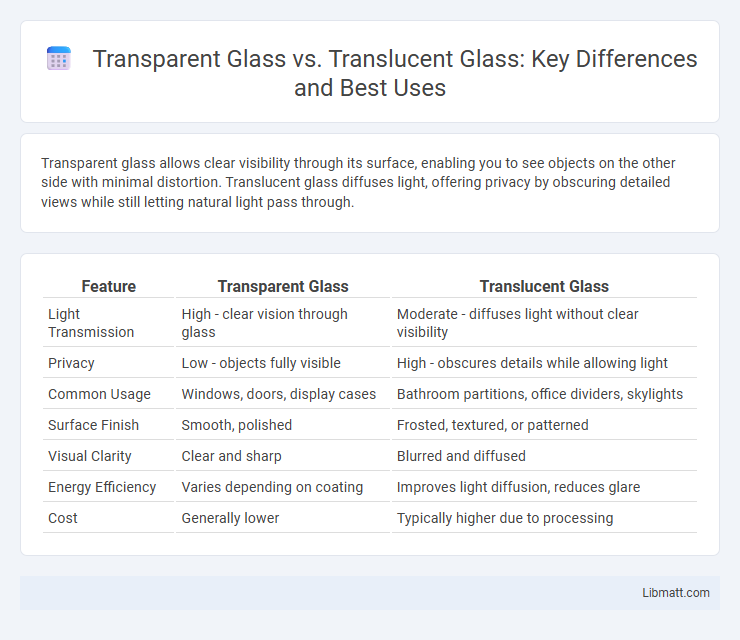Transparent glass allows clear visibility through its surface, enabling you to see objects on the other side with minimal distortion. Translucent glass diffuses light, offering privacy by obscuring detailed views while still letting natural light pass through.
Table of Comparison
| Feature | Transparent Glass | Translucent Glass |
|---|---|---|
| Light Transmission | High - clear vision through glass | Moderate - diffuses light without clear visibility |
| Privacy | Low - objects fully visible | High - obscures details while allowing light |
| Common Usage | Windows, doors, display cases | Bathroom partitions, office dividers, skylights |
| Surface Finish | Smooth, polished | Frosted, textured, or patterned |
| Visual Clarity | Clear and sharp | Blurred and diffused |
| Energy Efficiency | Varies depending on coating | Improves light diffusion, reduces glare |
| Cost | Generally lower | Typically higher due to processing |
Introduction to Transparent and Translucent Glass
Transparent glass allows nearly all visible light to pass through, providing clear visibility and true color representation, making it ideal for windows, display cases, and optical instruments. Translucent glass diffuses light, scattering it to prevent clear images while still permitting ambient illumination, commonly used in privacy windows, bathroom doors, and decorative panels. Both types serve distinct functional and aesthetic purposes based on their light transmission properties and application requirements.
Defining Transparent Glass
Transparent glass allows light to pass through without significant distortion, enabling clear visibility of objects on the other side. It is commonly used in windows, display cases, and eyeglasses, where clarity and unobstructed views are essential. Your choice of transparent glass ensures maximum light transmission and accurate color representation.
Defining Translucent Glass
Translucent glass diffuses light, allowing it to pass through while obscuring clear visibility, unlike transparent glass which offers crystal-clear views. This type of glass is commonly used in privacy applications such as bathroom windows, office partitions, and decorative panels where light transmission is desired without direct line of sight. Materials like frosted, sandblasted, or textured glass fall under translucent glass, providing both functionality and aesthetic appeal in architectural design.
Key Differences Between Transparent and Translucent Glass
Transparent glass allows clear visibility through its surface, enabling light to pass with minimal distortion, while translucent glass diffuses light, providing privacy by obscuring detailed views. Transparent glass is commonly used in windows and display cases where clarity is essential, whereas translucent glass is ideal for bathroom windows, shower doors, and privacy panels. Understanding these key differences helps you choose the right glass type to balance light transmission and privacy needs.
Common Applications of Transparent Glass
Transparent glass is commonly used in windows, automotive windshields, and smartphone screens due to its clarity and ability to allow unobstructed views. It is ideal for applications requiring maximum visibility and natural light, such as storefronts, greenhouses, and picture frames. Your space benefits from transparent glass when enhanced brightness and clear sightlines are essential.
Common Uses for Translucent Glass
Translucent glass is frequently used in bathrooms, office partitions, and decorative panels to provide privacy while allowing natural light to filter through. It is ideal for skylights, shower enclosures, and conference rooms where diffused light enhances ambiance without compromising confidentiality. Your spaces benefit from the balance of illumination and seclusion that translucent glass uniquely offers.
Advantages of Transparent Glass
Transparent glass provides superior clarity and visibility, making it ideal for applications where unobstructed views are essential, such as windows, display cases, and automotive windshields. It allows maximum light transmission, enhancing natural illumination and reducing the need for artificial lighting. Its ability to showcase true colors and details makes it favored in both residential and commercial settings for aesthetic and functional purposes.
Benefits of Translucent Glass
Translucent glass offers enhanced privacy by diffusing light without compromising natural illumination, making it ideal for bathrooms, offices, and meeting rooms. It reduces glare and softens harsh sunlight, improving comfort and energy efficiency in your space. This type of glass also adds aesthetic appeal with its frosted or textured surfaces, blending functionality with stylish design.
Choosing the Right Glass: Factors to Consider
Choosing the right glass involves understanding the differences between transparent and translucent glass, as transparent glass offers clear visibility and maximum light transmission, ideal for windows and display cases. Translucent glass diffuses light, providing privacy while still allowing natural illumination, making it suitable for bathrooms, office partitions, and decorative elements. Your decision should consider factors such as desired privacy, light control, aesthetic preferences, and the specific functional needs of your space.
Conclusion: Transparent vs Translucent Glass for Your Needs
Transparent glass offers clear visibility and maximum light transmission, making it ideal for applications requiring unobstructed views, such as windows and display cases. Translucent glass diffuses light while providing privacy, suitable for bathrooms, office partitions, or decorative purposes. Your choice depends on whether clarity or privacy is the priority in your space design.
Transparent glass vs translucent glass Infographic

 libmatt.com
libmatt.com